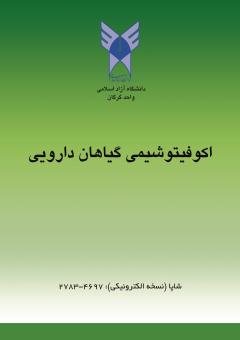شناسایی اکسیشن¬های چای غنی از آنتوسیانین در مناطق مختلف چایکاری استان گیلان
محورهای موضوعی : گیاهان دارویی
طاهره رضایی
1
,
امیر صحرارو
2
*
,
احسان کهنه
3
![]() ,
معظم حسن پوراصیل
4
,
معظم حسن پوراصیل
4
1 - گروه علوم باغبانی دانشگاه گیلان
2 - عضو هئیت علمی گروه باغبانی دانشکده کشاورزی- دانشگاه گیلان
3 - پژوهشکده چای، موسسه تحقیقات علوم باغبانی، سازمان تحقیقات، آموزش و ترویج کشاورزی، لاهیجان، ایران
4 - گروه علوم باغبانی- دانشگاه گیلان
کلید واژه:
چکیده مقاله :
تنوعبخشی به محصولات و افزایش ارزشافزوده با تولید فرآوردههای جدید دارویی و بهداشتی از چای، یک روش استراتژیک برای بهبود وضعیت تولید و اقتصادکردن چای است. در سالیان اخیر ژنوتیپ¬های چای حاصل از انتخاب طبیعی بارنگ برگ ارغوانی در برخی از کشورهای چای¬خیز معرفیشده است. با توجه به اینکه امکان حضور این قبیل ژنوتیپ¬ها در باغ¬های چای گیلان نیز وجود دارد، تحقیق حاضر باهدف شناسایی و انتخاب بوته¬های چای بارنگ ثابت ارغوانی که حاوی مقادیر بیشتر آنتوسیانین است اجرا شد. بدین منظور با پایش میدانی، بوتههای چای ارغوانی با رنگ پایدار از شهرهای استان گیلان شناسایی و پلاکگذاری گردید و سپس برگها (یک غنچه و دو برگ) برای آنالیز مقدار رنگدانهها مورد بررسی قرار گرفت. نتایج نشان داد که عوامل محیطی، تغذیه خاک و عملیات هرس در مکانهای مختلف توانسته تأثیر مثبتی بر میزان رنگدانهها در طی رشد و نمو بوتههای چای ارغوانی داشته باشد. بهطوریکه نمونه شمارههای 10 5983/12 μg · g–1, DW))، 19 4865/50 μg · g–1, DW)) و 16 (4451/10 μg · g–1, DW) به ترتیب در شهرستانهای لاهیجان و آستانهاشرفیه دارای بیشترین فعالیت آنتوسیانین و کمترین فعالیت آنتوسیانین در نمونه شماره3 (1390/93 μg · g–1, DW) در شهرستان لنگرود بود. بالاترین میزان کلروفیل¬های a، کل و کاروتنوئید در نمونه شماره 35 به ترتیب (1/07, 1/53 and 2.49 mg·g −1 DW) و کمترین مقدار کلروفیل¬های a، کل و کاروتنوئید در نمونه شماره 5 به ترتیب (0/46, 0/71 and 1/26 mg·g −1 DW) در شهرستان آستانهاشرفیه به دست آمد که عواملی از قبیل (شدت تابش، حاصلخیزی خاک، ارتفاع از سطح دریا و عملیات هرس) در این پدیده دخیل بودند. لذا اکسیشن¬های با مقدار بالاتر و تغییرات زمانی کمتری در مقدار آنتوسیانین دارد میتواند برای تحقیقات بعدی به منظور تولید نهال چای غنی از آنتوسیانین مورد پایش و مطالعه قرار گیرد.
Diversifying products and increasing added value by producing new medicinal and health products from tea is a strategic method to improve the production situation and economize tea. In recent years, tea genotypes resulting from the natural selection of the purple-leafed variety have been introduced in some tea-growing countries. Considering that there is a possibility of the presence of such genotypes in the tea gardens of Gilan, the present research was carried out to identify and select the constant purple-colored tea plants that contain higher amounts of anthocyanins. For this purpose, through field monitoring, purple tea plants with stable color were identified and labeled from the cities of Gilan province, and then the leaves (one bud and two leaves) were examined to analyze the amount of pigments. The results showed that the environmental factors, soil nutrition and pruning operations in different places had a positive effect on the amount of pigments during the growth and development of purple tea plants. So that sample numbers 10 (12.5983 μg·g–1, DW), 19 (50.4865 μg·g–1, DW)) and 16 (10.4451 μg·g–1, DW) respectively in Lahijan and Astana Ashrafieh had the highest anthocyanin activity and the lowest anthocyanin activity in sample number 3 (1390/93 μg·g–1, DW) in Langrod city. The highest amount of chlorophyll a, total and carotenoid in sample number 35 (1.07, 1.53 and 2.49 mg·g −1 DW) respectively and the lowest amount of chlorophyll a, total and carotenoid in sample number 5, respectively (0.46, 0.71 and 1.26 mg·g −1 DW) were obtained in Astana Ashrafieh, and factors such as (radiation intensity, soil fertility, altitude above sea level and pruning operation) were involved in this phenomenon. Therefore, extractions with a higher amount and less temporal changes in the amount of anthocyanin can be monitored and studied for future research to produce tea seedlings rich in anthocyanin.

